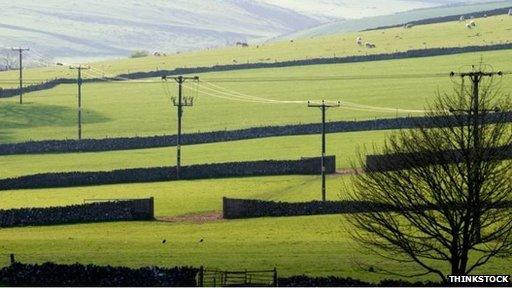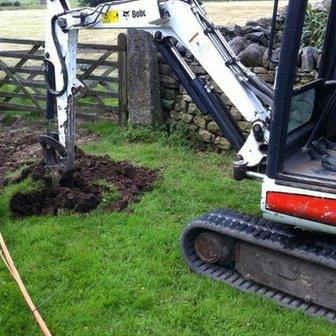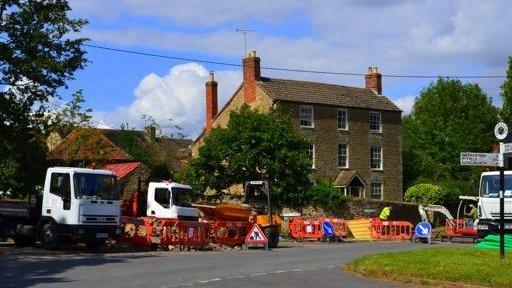Rural broadband: How to reach the broadband notspots
- Published

Will BT be the only option for fast broadband in the countryside?
Over the summer there was a lot of digging going on in the Lancashire countryside.
Nothing unusual there you may think until you realise that these trenches are being built to house a fibre optic network with speeds to rival those that Google is installing in Kansas City.
The community-led Broadband 4 Rural North (B4RN) scheme offers speeds of up to 1Gbps (gigabit per second) to communities along its route.
And as it expands its network, more villages are asking if they can be connected too, proving that if you build it, they will come.
The project has hit problems - some minor, like a delay over the summer caused by some nesting lapwings, but some bigger, for example when Network Rail refused permission for the ducts to run over a bridge, forcing it to reroute in a river.
However its biggest problem is money. Despite raising £300,000 worth of local investment, the team behind the project estimate that the total cost will be £1.86m.
It applied for a government grant but is still waiting to hear whether it will qualify while it is also finding it tricky to get a loan.

Some are digging their way to a faster future
It illustrates the difficulty of getting even a small-scale broadband network up and running and also begs the questions - why would farmers digging the trenches even want to take on such a project?
The reality is that they and other local residents are fed up with slow or non-existent broadband.
Commercial broadband providers like BT see no profit in rolling out complicated networks to a handful of houses in the middle of nowhere.
And that is rather galling for the people living in such communities who need broadband just as much, in some cases more, than their urban counterparts.
Broadband is now widely acknowledged as the fourth utility, and the government is all too aware that it needs to close the digital divide between town and country.
But its solution - to offer £530m to councils to subsidise rural broadband roll-outs - has been widely criticised, most recently in a report from a group of MPs who make up the Public Accounts Committee (PAC).
The process has been painfully slow. Initially the Department of Media, Culture and Sport (DCMS) planned to complete the roll-outs by 2015.
Now that has been put back to 2017, with the caveat that up to 10% of the country will still not be covered.
When it became clear that former telecoms monopoly BT had won every single council contract, there were some angry reactions.
The PAC report accused the DCMS of ripping off taxpayers by simply handing public money to BT.
This week as BT puts the final dots on those contracts, the big question is where does it leave the community schemes like B4RN?
While the current subsidy is now gone, the PAC report recommended the government make every effort to ensure that the next round of public funding - the £250m earmarked for the final 10% not covered in current plans - is spent more wisely.
"It can't simply be put into a pot marked BT. There has to be more competition. This is a good opportunity to make government funding go a lot further," said Malcolm Corbett, who heads up the independent networks co-operative association (Inca).
He estimates that the local community broadband schemes supported by his organisation can offer a much faster service to remote communities and require far less state aid than that demanded by BT, largely because they rely on co-investments with the local people.
It is a view that the government does not seem to share. A separate £20m provided by the Department for Environment, Food & Rural Affairs (Defra) to specifically fund innovative rural broadband schemes, including Lancashire's B4RN project, looks like it could be going the same way as the money provided by the DCMS.
"Our information indicates that almost all of the money will go to BT," said Mr Corbett.
"I'm on the point of giving up. Whatever we do and despite an extraordinarily critical government report, we still can't get these schemes out there. BT is just so powerful," he said.
Don't preach
BT's managing director of Next Generation Access, Bill Murphy, is not surprised that community schemes are struggling to gain headway.
"Our payback on rural broadband is 15 years. This is not for the faint-hearted. If people want to go build, then go build but, as I tell them, broadband networks aren't just for Christmas,"
And he is dubious that community schemes can roll out networks cheaper than BT.
"I spend a lot of time sitting in village halls hearing about how they want to build their own thing but none of them have ever built anything before. I admire their passion and commitment but I'm not going to be preached at by people who don't have the experience. Don't tell me that you can build a network cheaper than me," he said.
Coverage maps
One of the biggest criticisms in the PAC report was that BT and local authorities are failing to provide detailed information about how far their roll-outs would extend.
Without such information it will be hard for rivals to offer projects to compete with BT.

In Oxfordshire, Gigaclear has villages queuing up to get its broadband
Gigaclear is one such rival. It is offering a 1Gbps fibre to the home service to homes in Oxfordshire and Rutland and hopes to extend its footprint to Hampshire and Kent.
But lack of certainty about where BT may build networks is hampering its efforts.
"Under the current contracts drawn up with BT, councils can't say what areas will be upgraded until three months beforehand," said their marketing director Joe Frost.
"It means that whole areas will not be told anything for two years. That is a problem for them and for us," he said.
The issue has led the Countryside Alliance to demand change.
"BT and the local authorities aren't being transparent about where the roll-out will cover. We need to see a map with postcode trackers showing what communities will be left out," said their head of policy Sarah Lee.
For its part, BT said that it is up to local authorities to provide this information and that increasingly they are doing so.
Anyone wanting to know whether their community will be covered by the current roll-out has simply to phone their council, added Mr Murphy.
Fibre battle
One of the most interesting things about the alternative community schemes is that they tend to favour faster fibre to the home technology (FTTH) over BT's preferred fibre to the street cabinet (FTTC), even though it is far more expensive to lay.
Retired engineer Walter Wilcox has campaigned for years to get better broadband in the village of Ewhurst in Surrey and when it finally did come, he was unhappy with it.
"There are 76 houses that can't get the service, two properties where the fibre service is worse than the one they had before and we estimate 226 properties out of about 942 are unable to achieve the lower limit of 24 Mbps," he said.
The upgrade was done by BT using FTTC.
BT admits that the upgrade in Ewhurst took "longer than it should" and that 'there is still work to do".
"There are about 5% of people in the village who can't get the service but we are working on solutions to fix this." said Mr Murphy.
But what has happened in Ewhurst could be replicated around the country because, with a few exceptions, it is the technology that will form the backbone of BT's rollout.

As part of the B4RN project, they are installing their own cabinets
Many worry that FTTC is already an outdated technology, ill-suited to rural communities because the speed you get is in relation to how close you live to a street cabinet.
In contrast the FTTH technology favoured by B4RN and other community schemes offers the same speed to everyone - and with a top speed of 1Gbps it is not going to be past its sell by date any time soon.
As Chris Conder who sits on B4RN's management team puts it: "Fibre to the cabinet is like giving people a cold water tap whereas with fibre to the home they can have a hot power shower."
B4RN already has plenty of satisfied customers on its network but whether it and others like it are really equipped for a nationwide fibre battle with BT remains distinctly uncertain.
But there are plenty of people living in some of Britain's remotest places rooting for them.
- Published26 September 2013
- Published1 September 2013
- Published24 July 2013